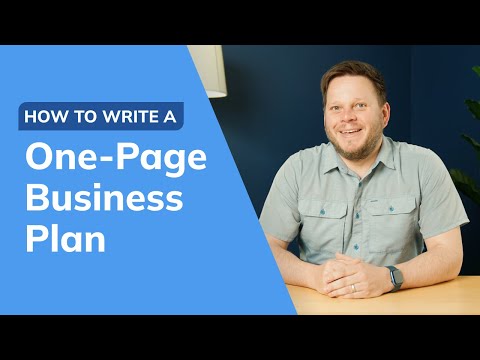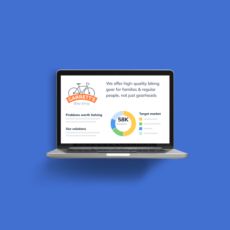How to Write a One-Page Business Plan
The most challenging part of writing a business plan is getting started. Create a one-page plan as a starting point.
A one-page business plan is simple to create, easy to update, and built for adaptation. It includes the essential components of a traditional plan but is briefer and more focused.
Think of it like you’re tweeting about your business. You have a limited number of characters to work with and are intentionally making it easy to digest. If you need additional support, download our free one-page plan template.
What is a one-page business plan?
A one-page business plan is a simplified version of traditional operational plans that focuses on the core aspects of your business. It follows the structure of a standard business plan and serves as a pitch document.
There’s not much difference between a single-page business plan and a good executive summary. In fact, as you create a more detailed plan, you may even use it as your executive summary.
What to include in your one-page plan
Include these eight sections when developing your one-page business plan.
Try to keep each section limited to 1-2 sentences or 3-4 bullet points to stay within one page. It’s easier to add more later than to cut back from lengthy sections.

The problem:
A description of the problem or need your customers have and any relevant data that supports your claim.
The solution:
Your product or service and how it solves the problem.
How you will make money— including the costs of production and selling, and the price that customers will pay.
Who is your customer and how many of them are there? Define your ideal customer by starting with a broad audience and narrowing it down. This provides investors with a clear picture of your thought process and understanding of the greater consumer market.
Competitive advantage:
What makes you different from the competition? Explain how this will lead to greater success, customer loyalty, etc.
Management team:
The management structure of your business, including currently filled roles, ideal candidates, and any management gaps.
Financial summary:
Key financial metrics include your profit and loss, cash flow, balance sheet, and sales forecast. This section may be difficult to condense, so focus on visualization and standard business ratios to get the point across. Share broader financial information if requested.
Funding required:
Have the total funding you need front and center to clearly display your ask from investors.
Why you should start with a one-page plan
1. It’s faster:
Instead of slogging away for hours or even weeks tackling a formal business plan, the one-page format helps you get your ideas down much faster. It removes complex formatting.
2. A great format for feedback:
Need quick feedback from business partners, colleagues, potential customers, or your spouse? Provide them with a one-page plan for better results. It’s more likely to be read and reviewed, providing valuable and timely feedback.
3. Easy to update:
Entrepreneurs never get things right the first time. You’ll constantly be learning and receiving feedback, requiring you to iterate and revise your business concept. Instead of updating a large document every time, you can do it in minutes with a one-page plan.
4. Direct and to-the-point:
Learning to communicate your ideas clearly and directly is critical. Be sure that anyone can understand the essence of your business. Delivering your entire business concept on a single page is a great way to practice this, as it forces you to be succinct.
5. Works as an idea validation tool:
Initially, your business is just a set of assumptions that you need to validate. Do your potential customers have the problem you assume? Do they like your solution and are they willing to pay? What marketing and sales tactics will work? As you validate these assumptions, leave them in your plan. Assumptions that end up being wrong will quickly fall off the page.
6. Becomes an outline for your detailed plan:
If you need to create a detailed business plan document for investors or partners, use your one-page plan as your core outline. Expand and provide more details for each section.
7. No one really reads long business plans:
Traditional business plans are often too long and overly complex. Even when investors ask for a detailed document, chances are they won’t actually read every word. They may read certain sections, but often just want to see if you’ve thought through the details of your business, how it will operate, and how it will grow.
8. Useful for any business stage:
A one-page plan is useful for business owners mulling over ideas, just starting, actively managing, or looking to grow a business. It can help validate a business idea, work as an internal strategy document, or as a flexible management tool that can be adapted over time.
Resources to help write your one-page plan:
Check out our guide for quickly writing a one-page plan and download our free one-page plan template to kickstart the writing process.
How to write your one-page plan in under an hour:
Still feeling overwhelmed about creating a business plan? Check out this step-by-step guide to write a useful one-page business plan in as little as 30 minutes.

Download a free one-page business plan template to simplify the plan writing process.

Write plans faster with LivePlan. Try the business planning and growth tool trusted by over 1 million business owners.
Hello!
I’m Andrew Brooks, a seasoned finance consultant from the USA and the mind behind phonenumber247.com.
My career is built on a foundation of helping individuals and businesses thrive financially in an ever-changing economic landscape. At phonenumber247.com, my aim is to demystify the complex world of finance, providing clear, actionable advice that can help you navigate your financial journey with confidence. Whether it’s personal finance management, investment strategies, or understanding the nuances of market dynamics, I’m here to share insights and tools that can propel you towards your financial goals.
Welcome to my digital space, where every piece of advice is a step closer to financial clarity and success!
